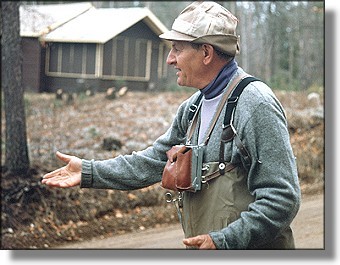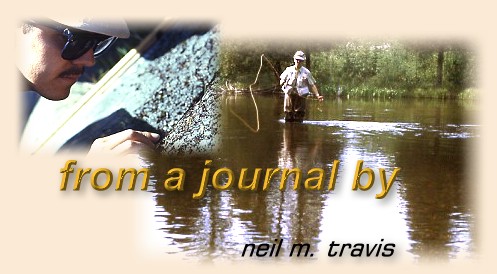Vincent C. Marinaro
By Neil M. Travis, Montana/Arizona
Sometimes as we travel down life's highway we cross paths
with a truly unique individual, and that was my good fortune
when, in the late 1960's, my life intersected with Vince
Marinaro. For a few years Vince and a group of his friends
from Pennsylvania made a yearly trek to fish Michigan's Au
Sable River and it was during this time that we met. While
I don't recall the exact details of how that first meeting
came about I had the privilege of fishing with him, joining
him for dinner on several occasions, and over the intervening
years corresponding with him. The personal letters, audio tapes,
and the autographed copies of his books are some of my most
treasured earthly possessions.
Vincent C. Marinaro was born in 1911 in western Pennsylvania,
and over the next 75 years he never strayed very far from his
Pennsylvania roots. He lived most of his life in Mechanicsburg,
in eastern Pennsylvania located in the heart of Pennsylvania's
legendary limestone country. Here Vince spent many hours on his
beloved Letort.

Vince was more than just a fly fishing genius; he was a corporate
tax specialist, a classically trained violinist and the master of
11 languages. He was a good cook, and I enjoyed excellent pasta
and fresh green salad with garbanzo beans at the cabin along the
banks of the Au Sable that Vince and friends called home while
they were fishing. Vince enjoyed a good cigar and the atmosphere
at that cabin was filled with cigar smoke, the aroma of pasta
sauce, and a shared camaraderie of brothers of the angle. Irascible,
opinionated, but in my experience always the gentleman. He made
an indelible mark on fly fishing.
A Modern Dry Fly Code was his first book, but when
it was published in 1950 fly fishing was experiencing the dark
ages, and in its first printing it was not a great success.
Fortunately this masterpiece was reprinted in 1970, and helped
to usher in the modern renaissance of fly fishing. In this book
Vince broke new ground in fly construction, raised the terrestrial
insect to major importance, and raised questions about how trout
perceive our imitations on the surface of the water. Vince
introduced the idea of using minuscule flies, or as he called them
'minutae,' to imitate the vast number of tiny insects that make up
the bulk of the insect biomass. Fishing with very small flies was
practiced by a few Pennsylvania limestoners, and Vince opened the
door to this method of fly fishing to a much wider audience.
As important as all of these things were, Vince's greatest
contribution to the world of fly fishing was the introduction
of the thorax–style of tying the dry fly. This was truly an
American innovation that moved the wing of the fly back on
the hook, used a unique style of hackling that did not obscure
the wing, and utilized widely split tails for stability. Vince
experimented with a variety of tying techniques that resulted
in such flies as the jassid, and spinners tied with porcupine
quill bodies.
In the Ring of the Rise, published in 1976, Vince
demonstrated another of his many talents when he explored, in
detail, the actions of a trout rising to an insect. Page after
page of sharp, detailed photographs show all the stages of a
trout's rise, and the photographs of the trout's view of a fly
moving into its field of vision are unequaled.
Vince taught himself the art of bamboo rod making, and I have
a bodkin handle in my fly tying cabinet that is a short section
of a bamboo rod that Vince gave me.
Vince built on the foundation that others had laid, but he was
also a great innovator and many of his ideas were revolutionary.
Well versed in the history of angling he was quick to give credit
to those who had preceded him, and like all true innovators he
had an insatiable curiosity, an inventive mind, and a willingness
to break with tradition.
While Vince was not the most prolific angling author what he
wrote is among the most profound and insightful in all of
fly fishing literature. In his book, American Fly Fishing,
A History, angling historian Paul Schullery made the
following comments on the importance of Vincent C. Marinaro
to the angling world.
"But for sheer originality and literary quality, no book of
this era approached Vincent Marinaro's A Modern Dry-Fly
Code [1950]. Marinaro's book, based on decades of
experience on the Letort, Big Spring, and other south
Pennsylvania streams, amounted to a substantial rethinking
of traditional dry-fly definitions. Not only did he espouse
a much broader imitation base including many terrestrials,
he reconsidered the structure of the dry fly as it had been
developed for mayflies. In all cases, his modifications,
though they may not have converted the majority of anglers,
found enduring niches in fly theory. Rarely has a fly-fishing
writer ventured to change so much and lived to see his work
recognized and incorporated into the body of fly-fishing
practice." [American Fly-Fishing, Paul Schullery,
Page 197-198]
The world of fly fishing lost a truly great man when Vincent
C. Marinaro died in 1986, but he left a tremendous legacy for
future generations, and set a standard of excellence for future
writers and innovators to follow. ~ Neil M. Travis, Montana/Arizona
From A Journal Archives
|

